|
|
|
 |
 |
 |
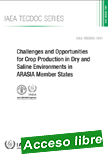 |
Challenges and Opportunities for Crop Production in Dry and Saline Environments in ARASIA Member States
IAEA TECDOC, 2018, 136 p.
This publication serves as a referencing guide for Member States and interested specialized readers wishing to work on agriculture in dry and saline environment, in particular located in the Middle East region. All information and instructions given in this guide are based on successful and sound practices applied in pertaining Member States for sustainable cropping of salt affected soils. |
It will help scientists and farmers to select management alternatives most efficient for agriculture in saline environments within their own countries. The publication also focuses on the possible use of isotopes techniques in dealing with salinity and droughts conditions affecting crop production.
|
 |
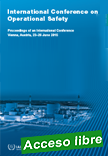 |
International Conference on Operational Safety - Proceedings of an International Conference Held in Vienna, Austria, 23–26 June 2015
Proceedings series (International Atomic Energy Agency. CD-ROM) , 2018, s. p.
This proceedings publication presents the essential content of the 2015 IAEA international conference on the operational safety of nuclear power plants. Although conferences on this topic are conducted regularly, this was the first one after the earthquake in 2011 that caused the accident at the Fukushima-Daiichi nuclear power plant. |
The conference brought together a broad range of participants including nuclear utilities, regulators, governments and academia. The topics covered operational safety, culture for safety, effective use of operating experience and the safety of long term operations, amongst others. A fresh perspective was added by representatives of other industries that deal with significant potential hazards. This publication, available exclusively in digital format, provides the reader with the opening and closing addresses, summaries of all sessions and the majority of the papers and posters accepted for the conference.
|
 |
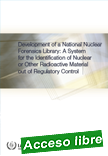 |
Development of a National Nuclear Forensics Library: A System for the Identification of Nuclear or Other Radioactive Material out of Regulatory Control
IAEA Non-serial Publications, 2018, 52 p.
This publication provides the rationale for the development of a national nuclear forensics library and addresses how a State may use such a national system in investigations of nuclear and other radioactive material out of regulatory control. Nuclear forensics is the examination of nuclear or other radioactive material, or of evidence that is contaminated with radionuclides, in the context of legal proceedings under international or national law related to nuclear security.
|
The analysis of nuclear or other radioactive material seeks to identify what the materials are, how, when and where the materials were made, and what their intended uses were. Important when conducting a nuclear forensics examination is the ability of States to identify nuclear and other radioactive material within the State and determine whether those materials are consistent with domestic holdings. As a system for the identification of nuclear or other radioactive material, a national nuclear forensics library can facilitate interpretation of findings and assist States in this determination. This publication seeks to assist States that choose to develop such a library tailored to their individual circumstances, national legal requirements, and security needs.
|
 |
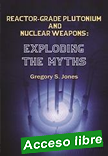 |
Reactor-Grade Plutonium and Nuclear Weapons: Exploding the Myths
Nonproliferation Policy Education Center, April 2018, 170 p.
In Reactor-Grade Plutonium and Nuclear Weapons: Exploding the Myths, long-time defense analyst Gregory S. Jones draws from his decades of research using publicly available, unclassified information to debunk the persistent fallacy that reactor-grade plutonium cannot be used to build reliable nuclear weapons. |
This belief has long been held by a segment of the nuclear power industry determined to use plutonium as reactor fuel despite its highly uneconomical nature. Further, this mistaken belief has made reactor-grade plutonium readily available to many non-nuclear weapon states.
In the book, Jones shows that nuclear weapons can be manufactured using reactor-grade plutonium that have the same predetonation probability, size, and weight as nuclear weapons using weapon-grade plutonium. In addition to technical analysis, the book describes how Sweden and Pakistan planned to use reactor-grade plutonium for their nuclear weapons programs and how India may be planning to do so today. Jones also details how the U.S. successfully tested a nuclear weapon using what was truly reactor-grade plutonium in 1962. All of this leads Jones to argue for banning plutonium recycling and reprocessing globally.
|
 |
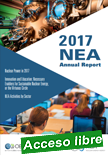 |
NEA Annual Report
Nuclear Energy Agency (NEA), 18/05/18, 75 p.
At the end of 2017, there were 446 operational reactors worldwide, representing 389 GW of capacity, with NEA member countries operating 351 units, representing 322 GW, or 83% of the total world capacity. Four reactors were connected to the grid in 2017 – three in China and one in Pakistan. Construction began on three reactors worldwide, bringing the total number of reactors under construction to 58 (20 in NEA member countries), with the construction of two reactors ceasing at Virgil C. Summer in the United States. |
Nuclear plant construction is most vigorous in nonNEA member countries, and this trend appears likely to continue. Countries anticipating strong growth in demand for electricity feature prominently among those planning to build additional plants. China is currently constructing 18 reactors (19 GWe), down from the 29 under construction in 2012 and 2013, but still one third of total construction.
|
 |
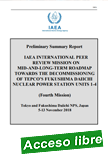 |
IAEA INTERNATIONAL PEER REVIEW MISSION ON MID-AND-LONG-TERM ROADMAP TOWARDS THE DECOMMISSIONING OF TEPCO’S FUKUSHIMA DAIICHI NUCLEAR POWER STATION UNITS 1-4 (Fourth Mission) - PRELIMINARY SUMMARY REPORT TO THE GOVERNMENT OF JAPAN
IAEA, 13 November 2018, 21 p.
Following the accident at TEPCO’s Fukushima Daiichi Nuclear Power Station (NPS) on 11 March 2011, the “Mid-and-Long-Term Roadmap towards the Decommissioning of TEPCO’s Fukushima Daiichi Nuclear Power Station Units 1-4” (hereinafter referred to the “Roadmap”) was adopted by the Government of Japan and the TEPCO (Tokyo Electric Power Company) Council on Mid-to-Long-Term Response for Decommissioning in December 2011.
|
The Roadmap was revised in July 2012, June 2013, June 2015 and September 2017. The Roadmap includes a description of the main steps and activities to be implemented for the decommissioning of the Fukushima Daiichi NPS through the combined effort of the Government of Japan and TEPCO. At the request of the Government of Japan, the IAEA organized three missions of the International Peer Review of the Roadmap, which were implemented within the framework of the IAEA Nuclear Safety Action Plan, in April 2013, in November/December 2013 and in February 2015, respectively. Those missions aimed at enhancing international cooperation and sharing with the international community information and knowledge concerning the accident to be acquired in the future decommissioning process. The Government of Japan conveyed, in an official correspondence dated 24 August 2018 through the Permanent Mission of Japan in Vienna, its request to the IAEA to dispatch another mission, and the IAEA accepted the request in an official correspondence dated 10 September 2018. During the 62nd IAEA General Conference (Vienna, 17-21 September 2018), the intention to receive another IAEA mission was confirmed (Terms of Reference was signed) by the representative of the Government of Japan, with the aim to continue to work together with the IAEA and the international community. Following this request, the fourth Mission of the International Peer Review of Mid-and-LongTerm Roadmap towards the Decommissioning of TEPCO’s Fukushima Daiichi Nuclear Power Station Units 1-4, involving 13 international experts, took place from 5 to 13 November 2018 (hereinafter referred to as the “Mission”). The objective of the Mission was to provide an independent review of the planning and implementation of Fukushima Daiichi NPS decommissioning. The Mission was conducted based on the IAEA Safety Standards, technical guidance and other relevant good practice, aimed at assisting the Government of Japan in the implementation of the Roadmap.
|
 |
 |
Country-Specific Safety Culture Forum: Sweden
Nuclear Energy Agency (NEA), 13/09/18, 56 p.
One of the many important lessons learnt about nuclear safety over the years has been that human aspects of nuclear safety are as important as any technical issue that may arise in the course of nuclear operations. The international nuclear community can work together to identify and address issues associated with components and systems and compare operational experiences, but identifying how human behaviour affects safety and the best approaches to examine this behaviour from country to country remains less common. |
Practical experience has nevertheless shown that there are important differences in how people work together and communicate across borders. People’s behaviours, attitudes and values do not stop at the gate of a nuclear installation, and awareness of the systemic nature of culture and its deeper aspects, such as the dynamics of how values and assumptions influence behaviours, continues to evolve.
The NEA safety culture forum was created to gain a better understanding of how the national context affects safety culture in a given country and how operators and regulators perceive these effects in their day-to-day activities. The ultimate goal is to ensure safe nuclear operations.
The first NEA safety culture forum – a collaborative effort between the Nuclear Energy Agency (NEA), the World Association of Nuclear Operators (WANO) and the Swedish Radiation Safety Authority (SSM) – was held in Sweden in early 2018. This report outlines the process used to conduct the forum, reveals findings from the discussions and invites the nuclear community to further reflect and take action.
|
 |
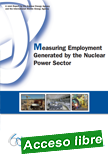 |
Measuring Employment Generated by the Nuclear Power Sector
Nuclear Energy Agency (NEA), 25/10/18, 96 p.
The nuclear energy sector employs a considerable workforce around the world, and with nuclear power projected to grow in countries with increasing electricity demand, corresponding jobs in the nuclear power sector will also grow. Using the most available macroeconomic model to determine total employment – the "input/output" model – the Nuclear Energy Agency and International Atomic Energy Agency collaborated to measure direct, indirect and induced employment from the nuclear power sector in a national economy.
|
The results indicate that direct employment during site preparation and construction of a single unit 1 000 megawatt-electric advanced light water reactor at any point in time for 10 years is approximately 1 200 professional and construction staff, or about 12 000 labour years. For 50 years of operation, approximately 600 administrative, operation and maintenance, and permanently contracted staff are employed annually, or about 30 000 labour years. For up to 10 years of decommissioning, about 500 people are employed annually, or around 5 000 labour years. Finally, over an approximate period of 40 years, close to 80 employees are managing nuclear waste, totalling around 3 000 labour years. A total of about 50 000 direct labour-years per gigawatt. Direct expenditures on these employees and equipment generate approximately the same number of indirect employment, or about 50 000 labour years; and direct and indirect expenditures generate about the same number of induced employment, or 100 000 labour years. Total employment in the nuclear power sector of a given national economy is therefore roughly 200 000 labour years over the life cycle of a gigawatt of nuclear generating capacity.
|
 |
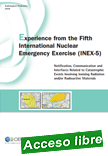 |
Experience from the Fifth International Nuclear Emergency Exercise (INEX-5) - Notification, Communication and Interfaces Related to Catastrophic Events Involving Ionising Radiation and/or Radioactive Materials
Nuclear Energy Agency (NEA), 07/09/18, 64 p.
The NEA has a long tradition of expertise in the area of nuclear emergency policy, planning, preparedness and management. Through its activities in this field, it offers member countries unbiased assistance on nuclear preparedness matters, with a view to facilitating improvements in nuclear emergency preparedness strategies and response at the international level.
|
A central approach to this has been the preparation and conduct of the International Nuclear Emergency Exercise (INEX) series.
The Fifth International Nuclear Emergency Exercise (INEX-5) was developed specifically in response to member countries? desire to test and demonstrate the value of changes put in place following the Fukushima Daiichi nuclear power plant accident. Exercise objectives focused on notification, communication and interfaces related to catastrophic events involving ionising radiation and/or radioactive material. The exercise was held during 2015 and 2016, with 22 countries participating in the exercise.
This report summarises the major evaluation outcomes of the national and regional exercises, policy level outcomes, recommendations and follow-up activities emerging from INEX-5 and the discussions at the INEX-5 International Workshop. A set of key needs were identified in areas such as real-time communication and information sharing among countries and international partners, improving cross-border and international co-ordination of protective measures and considering the mental health impacts on populations when implementing protective measures.
|
 |
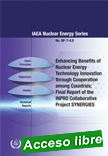 |
Enhancing Benefits of Nuclear Energy Technology Innovation through Cooperation among Countries: Final Report of the INPRO Collaborative Project SYNERGIES
IAEA Nuclear Energy Series, 2018, 3441 p.
This publication provides a summary of the INPRO collaborative project on synergistic nuclear energy regional group interactions evaluated for sustainability. Benefits of nuclear technology innovation can be amplified through co-operation among countries in the nuclear fuel cycle.
|
Nuclear energy sustainability can be enhanced, not only for technology holders but also for a variety of technology users, including those who do not pursue innovations in their home countries. If one partner in a synergistic collaboration is achieving enhanced sustainability, then the other partner(s) may achieve similar enhancement through collaboration without the requisite large national investments in technology, R&D and related infrastructure development. Within the publication, 28 case studies have been conducted by Member States to identify and evaluate mutually beneficial patterns of co-operation in the nuclear fuel cycle and the driving forces and impediments involved in such co-operation.
|
 |
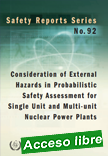 |
Consideration of External Hazards in Probabilistic Safety Assessment for Single Unit and Multi-unit Nuclear Power Plants
IAEA Safety Reports Series, 2018, 56 p.
This publication outlines the generic methodology for probabilistic safety assessment (PSA) of nuclear power plants (NPPs) against external hazards. It integrates design, procedural, operational, human factors and both protection and mitigation aspects that are essential to model a NPP response to an external hazard and to assess the associated risk.
|
It specifically addresses the identification and screening of external hazards considering the multi-unit impact.
|

|
|
|
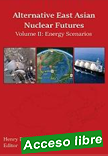 |
Alternative East Asian Nuclear Futures, Volume II: Energy Scenarios
Nonproliferation Policy Education Center, June 2018, 300 p.
This book, Alternative East Asian Nuclear Futures: Energy Scenarios, is the second of two volumes concerned about the security of East Asia. It asks two questions. How much nuclear power does East Asia really need? Can East Asia rely less on nuclear power through 2035? The answers matter because civilian nuclear energy programs could be exploited to make nuclear weapons in China, Japan, and the Koreas.
|
How much further this sector will expand in East Asia depends on several trends spotlighted in this volume. Natural gas prices increasingly will be less local and will instead reflect global market trends. These will be almost entirely independent of oil prices. As a result, natural gas is likely to remain plentiful and affordable for the generation of electricity for several decades. Nuclear power from large reactors and nuclear recycling costs and construction times are high and unlikely to fall. By contrast, electrical demand growth, the cost of renewables, natural gas-fired electricity, and electrical grid storage are falling and are likely to continue to do so. Meanwhile, improving grid transmission systems and developing more agile and experimental electrical pricing systems will help to reduce demand and encourage more economical forms of electrical generation. The question that remains is how much the governments in China, Korea, and Japan will recognize these developments.
|
| |
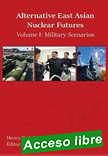 |
Alternative East Asian Nuclear Futures, Volume I: Military Scenarios
Nonproliferation Policy Education Center, June 2018, 194 p.
This book, Alternative East Asian Nuclear Futures: Military Scenarios, is the first of two volumes. It examines why and how Japan and South Korea might acquire nuclear weapons. It also details how North Korea and China might ramp up their nuclear arms production.
First released in draft form in 2015, much of this volumes’ research anticipated what is now unfolding in the region.
|
North Korea is developing a full-range of nuclear force capabilities. It is interested not just in deterring but in coercing its neighbors and the United States. The outcome of negotiations with North Korea remains unclear but Pyongyang now has cause to consider itself a nuclear-armed equal to America. China, meanwhile, is expanding its nuclear arsenal. At the same time, Japan may increase its large stockpile of weapons-usable plutonium by opening a large reprocessing plant at Rokkasho. It could produce approximately 1,500 bombs worth of plutonium a year. Finally, South Korea is considering reprocessing nuclear fuel and is interested in enriching uranium. South Korean conservatives, who may return to power in 2022, talk openly about acquiring nuclear weapons. These trends and more are described in this volume.
|
| |
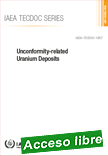 |
Unconformity-related Uranium Deposits
IAEA TECDOC No. 1857, 2018, 308 p.
This publication provides a description of existing and emerging technologies to effectively integrate geological, geophysical and geochemical data to recognize the footprint (i.e. the total extent that the mineralizing system has affected its environment) of the deposit and the key vectors to the uranium mineralization. In addition, insights into exploration strategies and risks associated with country and basin selection are discussed, including the role of the IAEA and academia in supporting the exploration process.
|
Representing an unprecedented, comprehensive reference document on unconformity-related uranium deposits with over 350 citations, this publication will be useful for decision makers at all levels, including governmental officers in energy and mineral resources, exploration companies, geologists, geological surveys, energy companies, universities and research institutions, and natural resource authorities.
|
| |
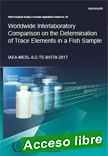 |
Worldwide Interlaboratory Comparison on the Determination of Trace Elements in a Fish Sample
IAEA Analytical Quality in Nuclear Applications Series, 2018, 74 p.
The Marine Environmental Studies Laboratory (MESL) of the International Atomic Energy Agency’s Environment Laboratories (IAEA-NAEL) has the programmatic responsibility to provide assistance to Member States’ laboratories in maintaining and improving the reliability of analytical measurement results for trace elements and organic pollutants.
|
This is accomplished through the provision of reference materials of marine origin, validated analytical procedures, training in the implementation of internal quality control, and through the evaluation of measurement performance of monitoring laboratories, via the organization of targeted worldwide and regional interlaboratory comparisons. In order to assure reliability of analytical data for monitoring studies, one essential aspect of quality assurance and quality control is the periodic external assessments measurement performance of laboratories in charge of monitoring studies via Interlaboratory Comparisons (ILCs) or Proficiency Tests (PTs). The results from ILCs or PTs are of crucial interest for laboratories as they provide clear information of their measurement capabilities. These exercises are designed to monitor the performance and analytical capabilities of the participating laboratoriesand to identify gaps and problem areas where further development is needed. Regular participation in the ILCs and PTs enhanced trust in results and methodologies and provides objective evidence for the accreditation purposes.
The present ILC was designed to evaluate the measurement performance of participating laboratories for the determination of trace elements in marine biota sample (fish). Letters of invitation have been sent to 293 laboratories, previously participated or expressed the interest in the IAEA ILCs. Positive responses were received from 111 laboratories from 57 Member States. 61 laboratories from 38 IAEA Member States received the ILC test sample. Each participating laboratory received one bottle of the test sample, accompanied by one information sheet and instruction for the use of the IAEA-NAEL on-line reporting system. Participants were requested to determine as many elements as possible from the following list of elements: Ag, As, Ca, Cd, Co, Cr, Cu, Fe, Hg, CH3Hg, K, Mg, Mn, Ni, Pb, Se, Sn, Sr, V and Zn, using analytical procedures routinely applied in their laboratories. In total 49 laboratories from 32 countries reported results back to the organizers. The data reported by laboratories, together with the technical and statistical evaluations of the results for investigated trace elements, are included in this report. All results were treated confidentially and each laboratory was identified with a unique confidential code number.
|
|
|
|
|
|
